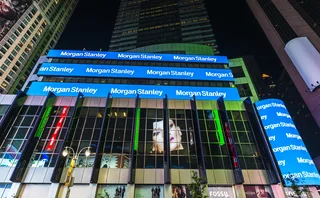
Whales or minnows? Sizing up crowded trades
Strategies for measuring crowding in trades can help to avoid its effect, writes quant fund founder
Sometimes, the more we think about the meaning of a seemingly obvious concept, the more it resembles a paradox – paradoxically, you might say.
A topical example of this is the crowded trade. The phenomenon has become a major talking point in the analysis of disappointing recent performances by many alternative beta and risk premia funds.
And while its central premise seems self-evident – when investors pile into any given trade, its future returns are de facto degraded – there is of course a flip side to this coin.
For every buyer, there is a seller. So, perhaps it could be argued that the opposite trade is crowded too. Paradoxically.
Which rather begs the question why so many perceive the crowded trade as toxic – and, if it is, whether it can be detoxified.
One potential remedy could be to devise a useful measure of crowding, which would allow us to construct portfolios with the greatest possible immunity to crowding risk.
In the minds of investors, the notion of crowding conjures up two distinct concerns.
One is that any mispricing that motivates a strategy is arbitraged away by the crowd, rendering that strategy unprofitable in the future.
The other is that crash risk – the risk of harmful deleveraging spirals – can occur if the crowd suddenly decides to run for the exits.
We then see how the symmetry between the two sides of a trade can be broken. The trade becomes crowded when investors on the buy side, say, are more prone to act collectively than those on the sell side.
The most crowded trade of all is – and always has been – going long the stock market. Stock market crashes have happened many times in the past and will happen again in the future – but this doesn’t make investing in the stock market a bad decision. On the contrary.
In fact, all risk premia are profitable in the long run, precisely because of such negatively skewed events. The equity risk premium is abnormally high – but in fact it compensates for the deleveraging risk associated with the madness of crowds.
In a 2015 paper published on Risk.net, I and my co-authors argued that the return of risk premia strategies are strongly correlated with their negative skewness – or their propensity to crash.
In many cases, crowding is simply unavoidable – the question is whether the associated downside risk is adequately compensated or not.
Which brings us back to the conundrum of withering returns.
Three’s a crowd
The standard mechanism offered as a solution is that the spread between the fundamental price and the market price is closed by those who trade based on that mispricing – if the cake is shared between a larger number, each person gets a smaller piece.
And, although this makes intuitive sense, the story cannot be that simple.
When we look at different measures of mispricing on which classical factors – e.g. momentum, profitability, low volatility – are supposed to thrive, there is no sign of a recent narrowing of the valuation spread between the short and long legs of the corresponding portfolios.
The situation is even the exact opposite for price-to-book spreads, which have become wider in the last five years. Which is tantamount to saying that value strategies are currently in the doldrums.
But to argue that the plight of value is due to crowding is at best misleading. Value as a strategy has been used extensively by market participants for decades.
What we are seeing is more like a value crash in slow motion, with investors getting out of this strategy more aggressively in the last two years. It follows a period of disappointing – but certainly not unprecedented – performance.
A rough estimation shows that if $250 billion is progressively redeemed from value strategies over a year, typical leveraged market-neutral value portfolios should suffer roughly a 20% loss from price impact alone – all very much in line with recent industry figures.
While there is no real indication that this is what happened recently, the argument that crowding is detrimental to convergent strategies – trades that reduce valuation spreads – is not without merit.
To argue that the plight of value is due to crowding is at best misleading. Value as a strategy has been used extensively by market participants for decades
Jean-Philippe Bouchaud
But then how do we understand the effect of crowding on divergent strategies, such as momentum or trend-following? Here, price impact arguments would suggest that more trend followers should bolster trends, not make them weaker.
Crowding could even be beneficial for such strategies – at least, up to a point.
The problem with this optimistic surmise is that it neglects yet another facet of price impact, namely transaction costs. According to our definition, crowded strategies are precisely the ones that lead to correlated trades – or many managers entering or leaving the market simultaneously.
As an extreme outcome, this can lead to crashes, as discussed above. But even in perfectly normal regimes, trading in the same direction as others can significantly increase impact costs or what’s known as ‘slippage’; it isn’t my own traded quantity that matters, it’s the aggregate quantity traded by all managers following the same trading idea.
Although the strength of the trading signal is not necessarily impaired, crowded trades may suffer from so much collective impact, or co-impact, that the profitability of the strategy quickly shrivels to zero – or below.
Far from the madness of crowds
This suggests an interesting metric to detect crowded strategies and estimate such co-impact costs.
The first step is to reconstruct the putative trades that a manager following a given strategy – say Fama-French Momentum – would send to the market on a given day. One then uses order-book tick data to determine the actual buy/sell order imbalances for each trading day. This allows us to compute the correlation of the overall market imbalance with the imbalance expected from the strategy under scrutiny.
A statistically significant correlation means that the strategy leaves a detectable trace in the markets. One can also measure the correlation between these reconstructed trades and the price return of each stock. This provides a direct estimate of the co-impact costs.
And this is precisely what our Capital Fund Management researchers have done in a forthcoming paper for Risk.net.
The conclusion is that the classical Fama-French Momentum has indeed become more and more crowded in the last 10 years, and, as of today, the estimated co-impact costs make the strategy all but unprofitable.
The good news is that there are many ways to implement a given trading idea – some more, some less correlated with the crowd.
And this paves the way to portfolio constructions that attempt to minimise the correlation of trades with identified trading strategies – in the hope of eschewing the curse of crowded trades – deleveraging spirals and all.
Jean-Phillipe Bouchaud is chairman of Capital Fund Management and member of the Académie des Sciences.
Editing by Louise Marshall
Only users who have a paid subscription or are part of a corporate subscription are able to print or copy content.
To access these options, along with all other subscription benefits, please contact info@risk.net or view our subscription options here: http://subscriptions.risk.net/subscribe
You are currently unable to print this content. Please contact info@risk.net to find out more.
You are currently unable to copy this content. Please contact info@risk.net to find out more.
Copyright Infopro Digital Limited. All rights reserved.
You may share this content using our article tools. Printing this content is for the sole use of the Authorised User (named subscriber), as outlined in our terms and conditions - https://www.infopro-insight.com/terms-conditions/insight-subscriptions/
If you would like to purchase additional rights please email info@risk.net
Copyright Infopro Digital Limited. All rights reserved.
You may share this content using our article tools. Copying this content is for the sole use of the Authorised User (named subscriber), as outlined in our terms and conditions - https://www.infopro-insight.com/terms-conditions/insight-subscriptions/
If you would like to purchase additional rights please email info@risk.net
More on Comment
Op risk data: Tech glitch gives customers unlimited funds
Also: Payback for slow Paycheck Protection payouts; SEC hits out at AI washing. Data by ORX News
Op risk data: Lloyds lurches over £450m motor finance speed bump
Also: JPM trips up on trade surveillance; Reg Best Interest starts to bite. Data by ORX News
Georgios Skoufis on RFRs, convexity adjustments and Sabr
Bloomberg quant discusses his new approach for calculating convexity adjustments for RFR swaps
In a world of uncleared margin rules, Isda Simm adapts and evolves
A look back at progress and challenges one year on from UMR and Phase 6 implementation
Op risk data: Morgan Stanley clocked in block trading shock
Also: HSBC deposit guarantee gaffe; Caixa hack cracked; reg fine insult to cyber crime injury. Data by ORX News
Digging deeper into deep hedging
Dynamic techniques and gen-AI simulated data can push the limits of deep hedging even further, as derivatives guru John Hull and colleagues explain
How AI can give banks an edge in bond trading
Machine learning expert Terry Benzschawel explains that bots are available to help dealers manage inventory and model markets
Op risk data: US piqued by Pictet tax breach
Also: US Bank’s Covid failings; South Korea’s short-selling clampdown. Data by ORX News








